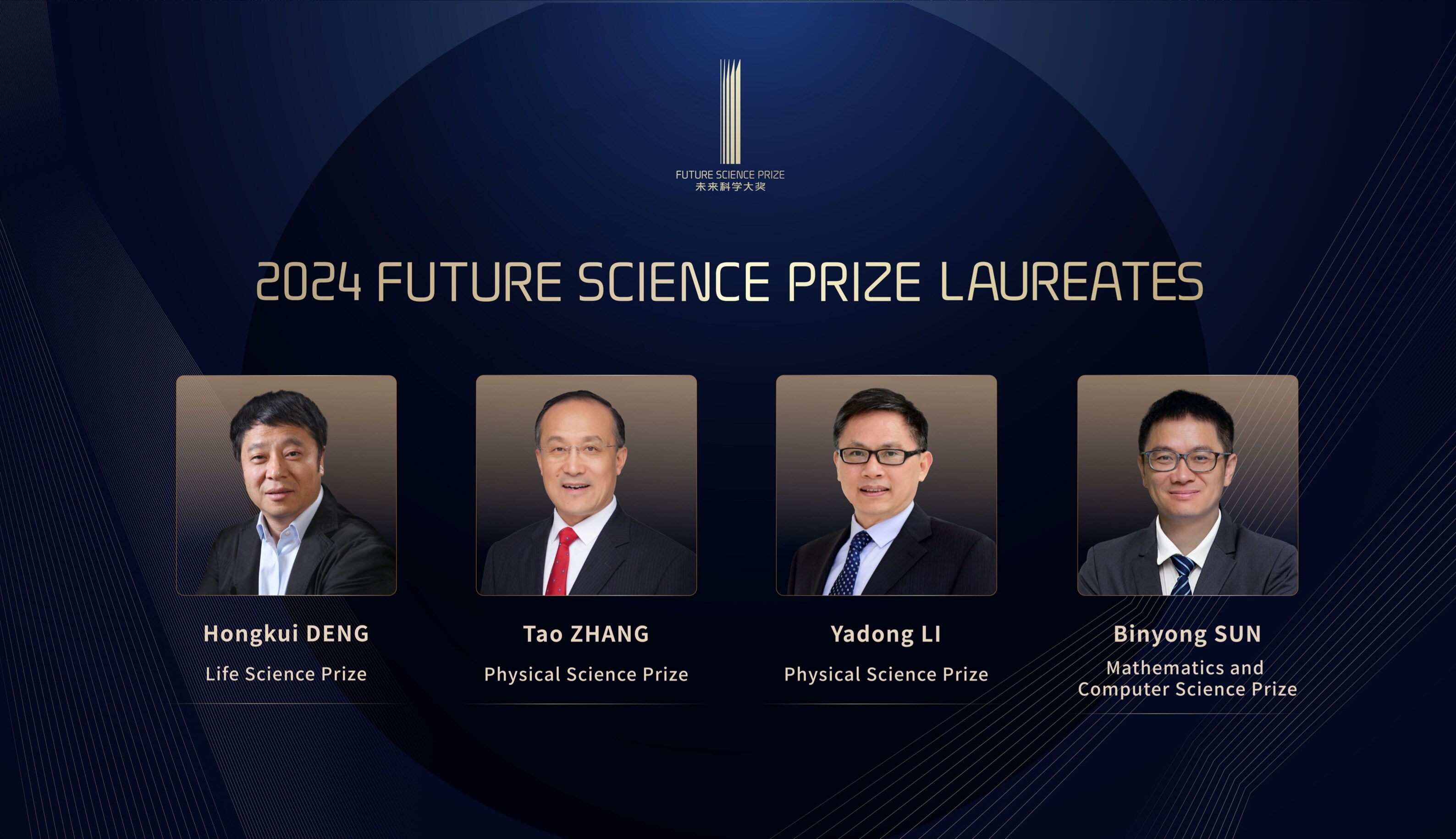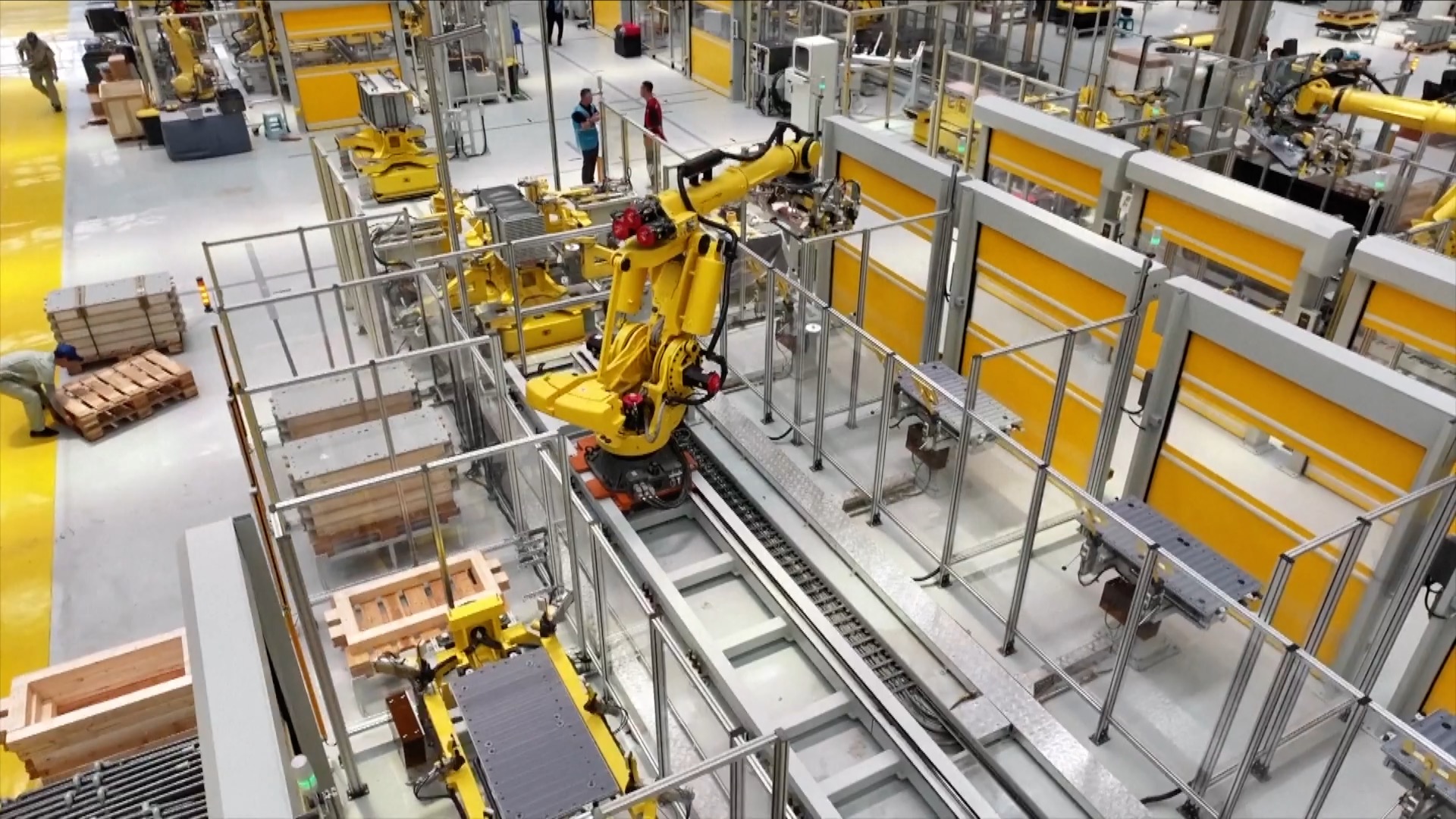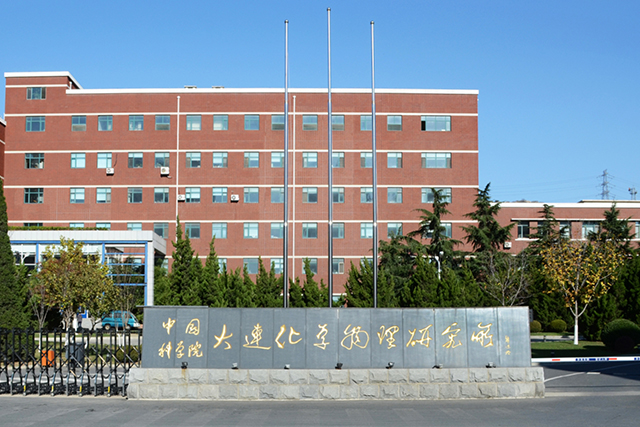DICP in Media
-
 08 20, 2024[Xinhua] Four scientists win 2024 Future Science PrizeThe winners of the 2024 Future Science Prize were announced in Beijing on Friday, Zhang Tao awarded the prize in physical sciences for his pioneering contributions to the development and application of Single-Atom Catalysis.The winners of the 2024 Future Science Prize were announced in Beijing on Friday, with four scientists receiving prizes in life sciences, physical sciences, mathematics and computer science, respectively.Deng Hongkui, Boya Chair Professor of Peking University and Leading Scientist of Changping Laboratory, received the prize in life sciences for his pioneering work on using chemical methods to reprogram somatic cells into pluripotent stem cells, thereby changing cells' fate and state.Zhang Tao, an academician of the Chinese Academy of Sciences from the Dalian Institute of Chemical Physics, and Li Yadong, a professor in the Department of Chemistry at Tsinghua University, shared the prize in physical sciences for their pioneering contributions to the development and application of Single-Atom Catalysis.Sun Binyong, a professor in the Institute for Advanced Study in Mathematics, Zhejiang University, was awarded the mathematics and computer science prize, for his remarkable contributions to the representation theory of Lie groups.The Future Science Prize was initiated in 2016 by a group of scientists and entrepreneurs, focusing on original basic scientific research. There have been 39 winners recognized so far.Related link: https://english.news.cn/20240816/1cecac9041c04b898f5b17d5ebfb323c/c.html
08 20, 2024[Xinhua] Four scientists win 2024 Future Science PrizeThe winners of the 2024 Future Science Prize were announced in Beijing on Friday, Zhang Tao awarded the prize in physical sciences for his pioneering contributions to the development and application of Single-Atom Catalysis.The winners of the 2024 Future Science Prize were announced in Beijing on Friday, with four scientists receiving prizes in life sciences, physical sciences, mathematics and computer science, respectively.Deng Hongkui, Boya Chair Professor of Peking University and Leading Scientist of Changping Laboratory, received the prize in life sciences for his pioneering work on using chemical methods to reprogram somatic cells into pluripotent stem cells, thereby changing cells' fate and state.Zhang Tao, an academician of the Chinese Academy of Sciences from the Dalian Institute of Chemical Physics, and Li Yadong, a professor in the Department of Chemistry at Tsinghua University, shared the prize in physical sciences for their pioneering contributions to the development and application of Single-Atom Catalysis.Sun Binyong, a professor in the Institute for Advanced Study in Mathematics, Zhejiang University, was awarded the mathematics and computer science prize, for his remarkable contributions to the representation theory of Lie groups.The Future Science Prize was initiated in 2016 by a group of scientists and entrepreneurs, focusing on original basic scientific research. There have been 39 winners recognized so far.Related link: https://english.news.cn/20240816/1cecac9041c04b898f5b17d5ebfb323c/c.html -
 08 14, 2024[CGTN] China's Liaoning cultivates new energy-storage industryThis is Liaoning Province's first global unicorn company in the port city of Dalian. Components for the vanadium redox flow battery energy storage system are being made here.This is Liaoning Province's first global unicorn company in the port city of Dalian. Components for the vanadium redox flow battery energy storage system are being made here.After more than 20 years of research, the Dalian Institute of Chemical Physics uncovered the energy storage properties of vanadium and developed the core technology of these batteries. In the city, the world's first 100-megawatt vanadium redox flow battery energy storage power plant has been set up. It can store 400 mWh of electricity, which can meet the daily power needs of 200,000 people.Related link: https://news.cgtn.com/news/2024-07-17/China-s-Liaoning-cultivates-new-energy-storage-industry-1vj6DmVS4dG/p.html
08 14, 2024[CGTN] China's Liaoning cultivates new energy-storage industryThis is Liaoning Province's first global unicorn company in the port city of Dalian. Components for the vanadium redox flow battery energy storage system are being made here.This is Liaoning Province's first global unicorn company in the port city of Dalian. Components for the vanadium redox flow battery energy storage system are being made here.After more than 20 years of research, the Dalian Institute of Chemical Physics uncovered the energy storage properties of vanadium and developed the core technology of these batteries. In the city, the world's first 100-megawatt vanadium redox flow battery energy storage power plant has been set up. It can store 400 mWh of electricity, which can meet the daily power needs of 200,000 people.Related link: https://news.cgtn.com/news/2024-07-17/China-s-Liaoning-cultivates-new-energy-storage-industry-1vj6DmVS4dG/p.html -
 04 28, 2024[Xinhua]Chinese Researchers Develop High-energy-density Aqueous BatteryA Chinese research team has developed a high-energy-density aqueous battery based on halogen multielectron transfer.
04 28, 2024[Xinhua]Chinese Researchers Develop High-energy-density Aqueous BatteryA Chinese research team has developed a high-energy-density aqueous battery based on halogen multielectron transfer.
BEIJING, April 26 (Xinhua) -- A Chinese research team has developed a high-energy-density aqueous battery based on halogen multielectron transfer, according to the Chinese Academy of Sciences (CAS).
Traditional non-aqueous lithium-ion batteries have a high energy density, but their safety is compromised due to the flammable organic electrolytes they utilize.
Aqueous batteries use water as the solvent for electrolytes, significantly enhancing battery safety. However, due to the limited solubility of the electrolyte and low battery voltage, aqueous batteries usually have a lower energy density. This means that the amount of electricity stored per unit volume of an aqueous battery is relatively low.
In a new study published in the journal Nature Energy, a research team led by Li Xianfeng from the Dalian Institute of Chemical Physics (DICP) of the CAS, in collaboration with Fu Qiang's team, also from the DICP, developed a multielectron transfer cathode based on bromine and iodine, realizing a specific capacity of more than 840 ampere-hour per liter.
To improve the energy density of aqueous batteries, researchers used a mixed halogen solution of iodide ions and bromide ions as the electrolyte. They developed a multielectron transfer reaction, which transfers electrons from iodide ions to elemental iodine and then to iodate.
Combining the cathode with metallic cadmium to form a full battery, the researchers achieved an energy density of up to 1,200 watt hour per liter based on the catholyte.
In the study, the bromide intermediate formed during the charging and discharging process optimized the reaction, effectively improving the kinetics and reversibility of the electrochemical reaction.
This study provides a new direction for the design of high-energy-density aqueous batteries, and may expand aqueous battery applications in the power battery field, Li said.
Related link: https://english.news.cn/20240426/c0c8e679f73b4cd38020b673d52ddfda/c.html -
 03 08, 2024[ChinaDaily]New Battery Operates Well in Cold TemperaturesChinese researchers have developed a new high-energy lithiumion battery that can operate reliably in temperatures as low as — 60 C, a feat that could significantly improve the performance of electric vehicles and other devices in extremely cold regions.
03 08, 2024[ChinaDaily]New Battery Operates Well in Cold TemperaturesChinese researchers have developed a new high-energy lithiumion battery that can operate reliably in temperatures as low as — 60 C, a feat that could significantly improve the performance of electric vehicles and other devices in extremely cold regions.
Chinese researchers have developed a new high-energy lithiumion battery that can operate reliably in temperatures as low as — 60 C, a feat that could significantly improve the performance of electric vehicles and other devices in extremely cold regions.
The battery, created by a team at the Chinese Academy of Sciences' Dalian Institute of Chemical Physics, boasts an energy density of 260 watt-hours per kilogram, even in extreme cold. That means it can store a significant amount of energy relative to its weight, ensuring efficient operation in harsh environments.
"This battery exhibits remarkable endurance, retaining over 80 percent of its capacity after 500 cycles at a wide range of temperatures," said professor Chen Zhongwei, head of the State Key Laboratory of Catalysis at the institute and leader of the research team.
The researchers achieved the breakthrough by addressing several key challenges. They developed a next-generation composite electrolyte that enhances the flow of ions within the battery, especially at low temperatures. And they also incorporated a multi-layer composite electrode structure with a novel semi-solid electrolyte and modified active materials, leading to improved stability and conductivity.
Those advances enhanced the battery's ability to perform consistently and deliver power efficiently even in extreme cold, Chen said.
The new battery also addresses safety concerns associated with traditional lithium-ion batteries, which primarily use liquid electrolytes, which can leak and ignite, posing a fire risk. The new design utilizes a proprietary semi-solid electrolyte, reducing the liquid component and therefore increasing fire resistance.
"This significantly reduces the risk of fire or explosion even under high temperatures," he said.
Beyond electric vehicles and outdoor energy storage, the batteries have the potential to revolutionize power supply and storage in various sectors, including aviation, aerospace and polar exploration, Chen added.
The research team is aiming to improve the battery's performance. It is developing the next generation with an even wider operational temperature range, targeting stable operation between — 70 C and 70 C and an energy density exceeding 280 Wh/kg.
"We are committed to achieving the country's carbon reduction goals and pushing the boundaries of energy technology," Chen said. "Through innovative, multidisciplinary research, we strive to establish China as a world leader in battery innovation."
Related link: http://www.chinadaily.com.cn/a/202403/07/WS65e92404a31082fc043bb274.html -
 12 04, 2023[ChinaDaily] Forum in Jiangxi Promotes Traditional MedicineThe 2023 Shanghai Cooperation Organization Forum on Traditional Medicine kicked off on Wednesday in Nanchang, Jiangxi province, and is expected to bring more opportunities to the growth of TCM.
12 04, 2023[ChinaDaily] Forum in Jiangxi Promotes Traditional MedicineThe 2023 Shanghai Cooperation Organization Forum on Traditional Medicine kicked off on Wednesday in Nanchang, Jiangxi province, and is expected to bring more opportunities to the growth of TCM.
The 2023 Shanghai Cooperation Organization Forum on Traditional Medicine kicked off on Wednesday in Nanchang, Jiangxi province, and is expected to bring more opportunities to the growth of TCM.
Under the theme "Heritage, Innovation, Unity and Collaboration for the High-Quality Development of Traditional Medicine Industry", the three-day event has attracted more than 500 Chinese and foreign experts, scholars and entrepreneurs from the medical industry.
They will discuss various topics such as the heritage and innovation of traditional medicine and the promotion of high-quality development in the traditional medicine industry.
The event is an opportunity to explore more experiences for the development of TCM, according to the organizing committee of Ganjiang New Area in Jiangxi province, where the forum is being held.
The new area has laid foundations for driving TCM into a high-quality growth direction, especially after it built the Traditional Chinese Medicine Science and Technology Innovation City, which has attracted numerous industrial projects and high-end scientific research talent since its construction in 2019.
One of the notable institutions in the city is the Ganjiang Chinese Medicine Innovation Center, co-established by the Dalian Institute of Chemical Physics, the Chinese Academy of Sciences and the Ganzhou New District Management Committee. With more than 200 employees, the center aims to tackle key scientific issues in traditional medicine, providing support for research and technological development in the industry.
Research results should not only stay in the laboratory but should be practically translated into economic value, according to the Traditional Chinese Medicine Science and Technology Innovation City.
By strengthening cooperation with research institutions, the center aims to promote technological innovation and application in the TCM industry, it added.
Chen Jianbin, vice-president of Shulei Biotechnology, said that the innovation city has a cooperative and win-win environment with good government services for enterprises and abundant human resources.
Jiangxi is known for its age-old history of traditional Chinese medicine and a robust basis for the development of TCM. For instance, Zhangshu in the province is known as the "Pharmaceutical Capital of China" and is renowned for its Chinese medicine industry.
Last year, Jiangxi achieved a comprehensive output value of more than 15 billion yuan ($2.1 billion) from medicinal material planting, with a business income of 41.7 billion yuan generated by over 150 large-scale Chinese medicine enterprises.
Related link: https://mobile.chinadaily.com.cn/cn/html5/2023-11/30/content_004_6567ab4fed50d203d2ca3843.htm -
 08 24, 2023[ChinaDaily]Chinese scientists synthesize sugar from carbon dioxideChinese scientists recently achieved precise total synthesis of sugar from carbon dioxide in the laboratory, marking a crucial step in artificial sugar synthesis.
08 24, 2023[ChinaDaily]Chinese scientists synthesize sugar from carbon dioxideChinese scientists recently achieved precise total synthesis of sugar from carbon dioxide in the laboratory, marking a crucial step in artificial sugar synthesis.
A photo taken on Aug 13, 2023, shows a researcher conducting experiment in the laboratory of Tianjin Institute of Industrial Biotechnology, Chinese Academy of Sciences. (Photo by Xinhua)
Chinese scientists recently achieved precise total synthesis of sugar from carbon dioxide in the laboratory, marking a crucial step in artificial sugar synthesis.
The synthesis, which took more than two years to realize, was achieved by teams from the Chinese Academy of Sciences' Tianjin Institute of Industrial Biotechnology and the academy's Dalian Institute of Chemical Physics.
Their research was published last week in a paper in Chinese Science Bulletin, a multidisciplinary academic journal.
Sugar is a major source of energy for the human body and a key raw material for industrial fermentation, and it is mainly obtained by extracting it from crops such as sugar cane.
However, the traditional method of extraction is limited by the energy conversion efficiency of plant photosynthesis. Moreover, the process of extracting sugar has been affected by uncertain raw material supplies due to land degradation and shortages, ecosystem degradation and extreme weather and natural disasters caused by global warming.
As a result, artificial sugar synthesis has been assiduously studied by the scientific community in recent years, and scientists around the world have contributed to the effort.
In their latest research, the Chinese scientists adjusted high-concentration carbon dioxide and other raw materials in the reaction solution in accordance with certain proportions. With the help of chemical catalysts and enzyme catalysts, they obtained four kinds of sugars: glucose, allulose, tagatose and mannose.
The experiment lasted about 17 hours, much shorter than the time required for traditional methods of sugar extraction, according to Yang Jiangang, lead author of the paper and associate researcher at the Tianjin institute.
The efficiency of sugar synthesis in this study was 0.67 grams per liter per hour, which was more than 10 times higher than the previous results achieved by scientists worldwide.
Yang said that the carbon dioxide to sugar conversion rate of glucose reached 59.8 nanomoles of carbon per milligram of catalyst per minute. This is the highest level of artificial sugar production known domestically and internationally.
The study also achieved precise control of artificial sugar synthesis.
"By controlling the varied catalytic effects of different enzymes, theoretically almost any type of sugar can be synthesized," Yang said.
Regarding the study, Manfred Reetz, a member of the German National Academy of Sciences Leopoldina, said it is a particularly challenging task to convert carbon dioxide into sugars.
Door for green chemistry
The achievement by Chinese scientists has provided a flexible, multifunctional and efficient sugar synthesis route, which opens a door for green chemistry, Reetz said.
Green chemistry, similar to sustainable chemistry, is a burgeoning field that focuses on how to fully utilize raw materials and energy in the process of producing the intended product while minimizing or eliminating the use and generation of harmful substances.
Carbon dioxide to sugar conversion is seen as an example of green chemistry, since it was conducted under normal temperature and pressure conditions and did not yield any harmful substances.
Related link: http://global.chinadaily.com.cn/a/202308/24/WS64e697a9a31035260b81de21.html